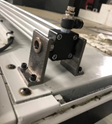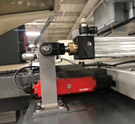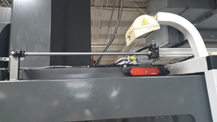When deploying a cobot for CNC machine tending applications the opening of the door needs to be automated. Most CNC machines have single or double doors which open manually unless the machine tool was ordered specifically from the factory with an auto door option.
There are different types of door opening systems to consider such as:
- Robot arm opens and closes the door
- Pneumatic cylinders
- Electric actuators
This blog focuses on automating the existing front entry doors on CNC mills and lathes. Front door loading is most common for cobot machine tending applications. These automation systems offer open, collaborative, work environments, always providing easy access to the CNC machine. They eliminate the need for protective fences, cages, or other safety items such as laser scanners or light curtains.
Method 1 - Robot opens the door
While this is the most cost-effective method based on the initial system price, it is not reliable and often leads to considerable lost production time. Collaborative robots are not designed to handle random encounters with varying forces. The robot may falsely detect collisions from imperfections in the door slide due to chip buildup resulting in unplanned stopped production. In addition, robots don’t open the doors as fast as an electric or pneumatic actuator, especially for double doors, because the robot can only open one door at a time.
Here is a video showing the robot opening the door:
Pros: Saves initial cost by eliminating the need to design/purchase/build/install/integrate an auto door system
Cons: Slow speed, poor reliability
Pneumatic Cylinders
Pneumatic cylinders are the most common method for traditional automation systems. It may sound easy and straight forward to mount a cylinder on the machine and have it actuate the door, however the biggest issue is the dimensional variation(s) in fabricated machine cabinets and doors. When actuated, the rod of the cylinder must extend precisely linearly when connected to the door. In many cases it is difficult to accomplish this. Flow control valves, pressure regulators, and bumpers are used to decelerate the door at open and close positions, however smooth acceleration/decelerations are typically not achievable resulting in door slam. There are inherent safety issues with pneumatic cylinders, since there is no way to stop a collision with an object or human, which can result in entrapment and injury. Using a rodless cylinder with a magnetic coupling, is a good safety practice but the breakaway force is not controllable. Pneumatic cylinders are also typically built to order and require special stroke lengths and mounting brackets, resulting in long lead times or awkward installations.
Below are some pictures and a video showing the installation of pneumatic cylinders on a Hass VF3 with double doors.



Shown below is a Doosan CNC Lathe with rodless pneumatic cylinder configured with magnetic breakaway. Notice how the doors slams after opening. Fine adjustment using flow control components are required to generate smooth operation.
Pros: speed of opening
Cons: lack of safety; force of cylinders can cause entrapment and injury, cylinders and brackets require engineering, custom manufacturing which drive up cost and lead time.
Electric actuators
The most effective electric actuator is a belt drive, servo motor system. These systems use standardized motors, gear boxes and mounting thus eliminating long lead times and the need to manufacture custom hardware. The belt is simply cut to length to adjust for various door opening widths. The force feedback makes the system “Collaborative”, meaning it will open like an elevator door if it detects a collision. The system self-teaches the forces required along the entire door travels for opening and closing to prevent false collision detections and controller can be set to make several attempts to open or close the door when a collision is detected. Also, the door controller applies smooth acceleration and deceleration profiles for fast, smooth movement without door slam. These door systems are new to the market and are by far the best choice when selecting a door system. Their cost is a bit higher compared to pneumatics, however the performance, reliability and their safety characteristics are superior to all other types of door actuation. The belt drive provides flexibility with dimensional variations in fabricated machine cabinets and doors and are easy to install.
Below are some videos where you can see the motor, door bracket, pulley and cover. These videos illustrate the smooth and reliable operation of the eclectic door system.
This video of the Haas VF4SS includes a Safety Demo showing how the door opens after collision
In this next video you can see that the electric door has been configured to use existing buttons on the control panel along with M-Code integration.
Notice the deceleration just before the door stops opening. There is no slamming.
Pros: Speed of opening, smooth operation, force feedback maximizes safety, ease of installation.
Cons: slightly higher cost compared to pneumatic
For more information on ProCobots Collaborative Robot Units visit: www.procobots.com
To learn more about ProCobots Auto Door options visit: https://procobots.com/cnc-machine-tending/auto-doors/

